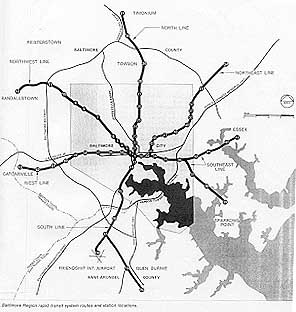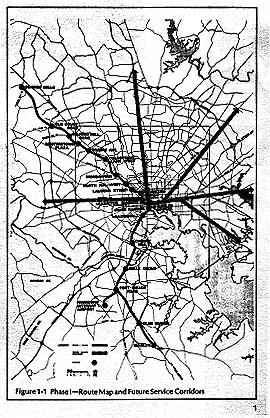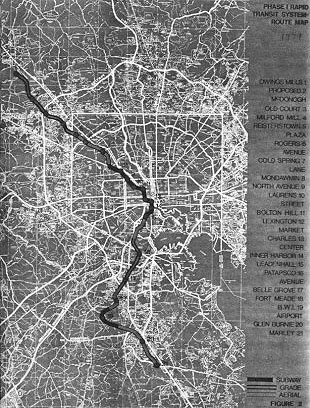The Metropolitan Transit Authority was established in June 1969 by Article
64B of the Annotated Code of the State of Maryland, and it was charged with the
responsibility of formulating a regional transit system. In conformance with the
legislative mandate of Section 9, Chapter 160 of the Statute, which states in
part - "The Board shall prepare a plan or plans to meet the transit needs of the
District ...", the Board of Directors of the Authority adopted on January 27,
1971, the Phase 1 Rapid Transit System as the official transit plan for the Baltimore
metropolitan area. The Phase 1 Plan used two lines from the 71-mile system, and
had a northwest line from the downtown to Owings Mills (terminal revised from
the Randallstown terminal in the 1968 report), and a south line from the downtown
to Glen Burnie and Friendship International Airport (today's Baltimore-Washington
International Airport (BWI)). The two lines in the Phase 1 Plan had a downtown
junction at an underground two-level transfer station at Charles Center. The rapid
rail transit south line eventually fell victim to funding limitations and local
opposition, and the
Central Light Rail Line was built along a similar
route to that of the once-planned rapid rail south line.
The Phase 1 Plan had 28 miles (44.8 km) of revenue line route and 20 stations,
and included all the necessary facilities to provide an operational system, including
stations, line structures, passenger rail cars, yards and shops, electrification
system, ventilating and heating systems, control and communications systems, automatic
fare collection system, and surveillance system. The system vehicles would be
steel wheeled, operating on steel rails. The vehicles would operate singly as
well as coupled in trains. The rail vehicles would be similar in many respects
to the ones that were then being designed for the rapid rail transit systems in
the Washington, D.C. area and in the San Francisco, California area. Train service
was proposed to run automatically, with most of the system having four-minute
minimum headways (train service spacing) during peak hours and ten-minute maximum
headways at other times, with service being provided 20 hours per day (5:00 AM
one day to 1:00 AM the next day). Predicted ridership for 1980 was 153,000 rail
trips on the average weekday. The fare structure would be compatible with the
bus fares in use in the Baltimore area. The construction period was proposed to
span from 1971 to 1978, and the estimated cost including inflation was $656 million
for the preliminary engineering, right-of-way, construction and physical elements
needed to make the system operational. Two-thirds of the capital cost, $437 million,
was expected to be provided by federal grants from UMTA (U.S. Urban Mass Transit
Administration, today's Federal Transit Administration). About 6 miles of line
would be underground in subway, with the remainder on the surface or aerial.



